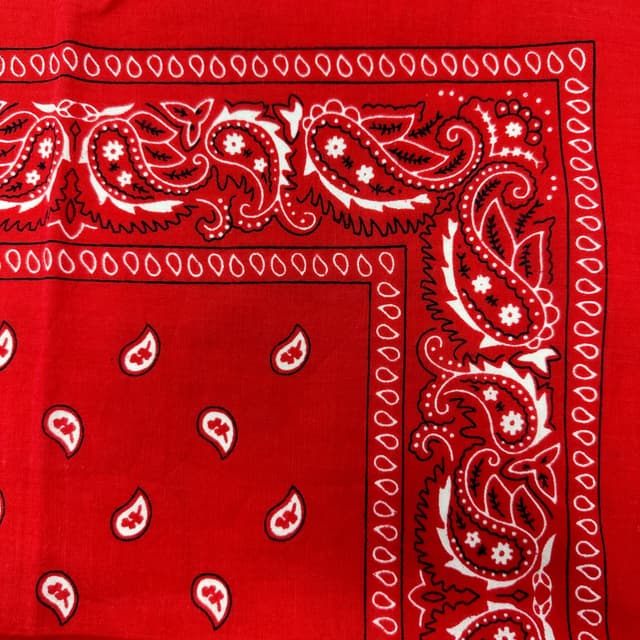Jann Schwarz | May 27, 2020
Why is this interesting? - The Bandana Edition
On protection, cultural codes, and pointed elephant trunks
Recommended Products

Teo currently has some lovely vintage red bandanas for sale, with all proceeds benefiting the Navajo Nation.
Jann Schwarz is a friend of WITI. Originally from the Engadine Valley in Switzerland, he now runs The B2B Institute at LinkedIn, a think tank helping companies do more interesting creative work to accelerate their growth. Elsewhere, he is a traveler, ravenous reader, connector, bon vivant, and as you will read here, a bandana and vintage connoisseur. We are pleased to have him on the page today. -Colin (CJN)
Jann here. By necessity more so than by choice, bandanas as make-shift face masks have become a pandemic fashion item. It’s yet another surprising turn in the long and storied history of the humble cotton square garment, which has had a unique and diverse representation in global and American culture for centuries.

The origin of the word bandana (or alternatively spelled bandanna) comes from the Hindi and Urdu bāṅdhnū meaning tie-dyeing, cloth so dyed. The garment itself has a history that can be traced back to South Asia and the Middle East in the late 1600s. From there it was brought back by the British East India Company and soon produced in Scottish mills, including in the paisley pattern which originates in Asia, but took its Western name from the Scottish town of Paisley.
In the late 1700s Martha Washington, had a souvenir bandana made featuring the likeness of her Commander-in-Chief husband, which popularized the printed bandana as a political campaign poster and later advertising medium.

With the migration out west in the 1800s, bandanas became an inexpensive and versatile tool for protection from the sun, cold, and dust for cowboys, miners and railway workers.
Most early bandanas of that period were dyed with Turkey Red dyes and imported from Scotland, and later manufactured in Rhode Island.
In the 20th century, the predominant American brand was Elephant Brand, which can easily be identified by the animal logo, which started with its trunk down and then was changed to up post-1950s.

In the second half of the 20th century the bandana became a symbol for different subcultures—from the outlaw motorcycle gangs to 1970s gay flagging codes and the LA Crips (blue) and Bloods (red) street gangs.
It later moved into Hip Hop, from Tupac to A$AP Rocky, whose yellow bandana had its own twitter feed for a while.
Most recently, as one would expect from a country partial to denim and other Americana, the Japanese have been obsessed with bandana-inspired fashion. A fine example is the brand KAPITAL, whose delightfully wacky bandanas and bandana jackets are treasured by aficionados.
There is even a museum in Japan devoted to the Elephant Brand history, located next to the Kapital store in Kojima, Okayama.
Why is this interesting?
Bandanas are perfect in so many ways. Inexpensive, unassuming, functional, versatile and yet also subversively flamboyant. They signal all kinds of cultural subtext, depending on the wearer. Bandanas are also great to collect because they don’t cost much and don’t take up much space.
I am by no means a serious bandana collector who fetishizes over tiny details, but I do enjoy a good vintage bandana for its softness and delicate, faded color. I find wearing them strangely comforting, though I was strictly a neck man until my pandemic mullet had to be tamed during Peloton sessions—a very 2020 scenario.
My personal fondness for bandanas started with my childhood in the Swiss Alps, where bandanas were a household staple as a hiking and skiing accessory, so there may be a Proustian madeleine thing going on for me.
But my love for the cotton squares really blossomed after a chance encounter with Scott Corey, a charismatic former cowboy and subsequent vintage Western clothing dealer and collector. Scott sold me three dozen or so exquisite examples from the 50s and 60s and taught me the basics (such as trunk up or down). Sadly, Scott passed away last year before I could visit his Santa Fe Vintage showroom. Luckily his associate Teo Griscom is carrying on with the business so I’ll definitely be paying an in-person visit post-pandemic.
Teo currently has some lovely vintage red bandanas for sale, with all proceeds benefiting the Navajo Nation. (JMS)
Lyric of the Day:
Left Los Angeles a short while ago
Flew 'cross the country back to Buffalo
Walked around through the sleet and the snow
With a red bandana on my head
Randy Newman, “Red Bandana”, from the 1988 Album “Land of Dreams” (JMS)
Quick links:
A dive into Japanese interiors in the FT (CJN)
On India/Chinese border skirmishes h/t Naveen (CJN)
No one is living on Dubai’s man-made islands (CJN)
Thanks for reading,
Noah (NRB) & Colin (CJN)
—
Why is this interesting? is a daily email from Noah Brier & Colin Nagy (and friends!) about interesting things. If you’ve enjoyed this edition, please consider forwarding it to a friend. If you’re reading it for the first time, consider subscribing (it’s free!).